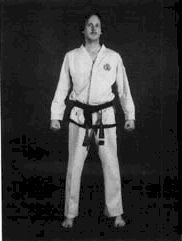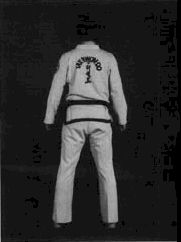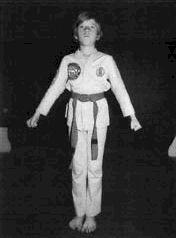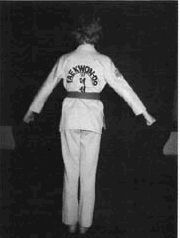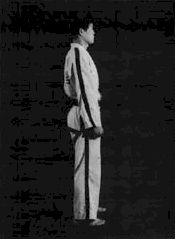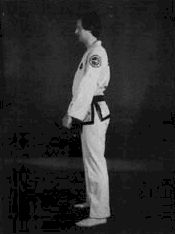(Do Bok)
| Black belt holder
Front View
Back View |
We assign names to people and objects in order to distinguish between different individuals, between objects with different properties etc. We know immediately that "Kim Sun Dal" is not the same person as "Timothy Smith", that "flora" is distinct from "fauna", that "rock" and a "pillow" do not have identical characteristics. The naming of names is a classification process by which we impose order on the universe. In the absence of names, the world would be chaotic and progress would be impossible. Our do boks serve a similar purpose. They reveal our occupation and our rank, identifying us as persons engaged in a certain kind of activity. Social order would be difficult to maintain without systemized forms of clothing. Because of names, football can be clearly distinguished from baseball, Taekwon-Do from Judo. Similarly, their respective uniforms allow us to distinguish a judge from a criminal, a general from a private soldier. When we wear a uniform, we accept a certain role in society and we are obliged to behave accordingly. Our martial art was given the name "Taekwon-Do" to distinguish its technique, philosophical system, spiritual foundation and rules of competition from other Oriental martial arts. We have a uniform unique to Taekwon-Do for the same reason. |
| The International Taekwon-Do Federation introduced this do bok in 1982. It is the product of many years of research and development. This new do bok retains the aspects of the traditional do bok while representing a new age in terms of design. It eliminates many of the inconveniences associated with other martial arts uniforms. It will not, for instance, become undone during practice or tournament. It has also put an end to the dishonest practice of relying on starched material to create an artificial sound. The do bok is considered a primary necessity in both training and tournament for the following reasons:
The do bok consists of a shirt, pants and belt made of synthetic material, detron mixed with cotton. This material is a vast improvement over standard cotton in that it is more durable and flexible. |
Grade holder
Front View
Back View International Instructor
Side View Black belt holder
Side View |
A tapered shirt is both more practical and aesthetically pleasing that a tight or loose one. The sleeves should be long enough to reach the wrist. The length of the shirt should be to the top of the thigh.
It is permissible to wear a T-shirt under the do bok if the student desires to do so.
Front View 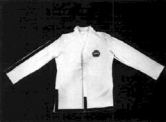 |
Back View 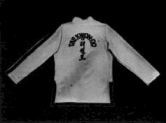 The logo symbolizes an evergreen tree. |
PANTS (Ha-i)
The length of the pants should be to the top of the ankle bone.
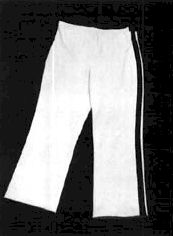 Front View
Front View 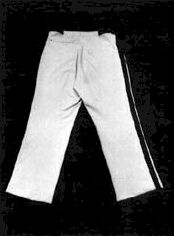 Back View
Back View
BELT (Ti)
There are six orders of belts; white, yellow, green, blue, red and black.
The width of the belt is five centimeters, the thickness five millimeters. The width of the stripe on the end of the belt is also five millimeters. The distance between the stripe and the end of the belt is five centimeters.
Black belt ranks are distinguished by Roman numerals on the belt as shown bellow.
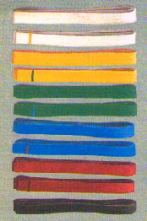 Grade holder's belt |
Black belt 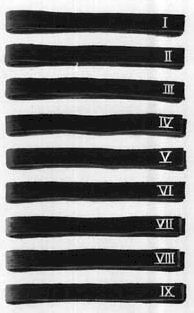 |
| Type of Belt Black Red belt with a black stripe Red belt Blue belt with a red stripe Blue belt Green with a blue stripe Green belt Yellow belt with a green stripe Yellow belt White belt with a yellow stripe White belt |
Rank First to Ninth Degree First Grade Second Grade Third Grade Fourth Grade Fifth Grade Sixth Grade Seventh Grade Eighth Grade Ninth Grade Tenth Grade |
The above colors have not been arbitrarily chosen. They are, in fact, steeped in tradition. The colors of black, red and blue denote the various levels of hierarchy during the Koguryo and Silla Dynasties. A half black and half white belt is used for the junior black belt holder.
MEANING OF BELT COLORS
| White - Yellow - Green - Blue - Red - Black - |
Signifies innocence, as that of a beginning student who has no previous knowledge of Taekwon-Do. Signifies the Earth from which a plant sprouts and takes root as the Taekwon-Do foundation is being laid. Signifies the plant's growth as the Taekwon-Do skill begins to develop. Signifies the Heaven, towards which the plant matures into a towering tree as training in Taekwon-Do progresses. Signifies danger, cautioning the student to exercise control and warning the opponent to stay away. Opposite of white, therefore, signifying the maturity and proficiency in Taekwon-Do. It also indicates the wearer's imperviousness to darkness and fear. |
How to fold the do bok
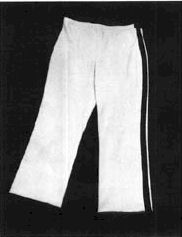 |
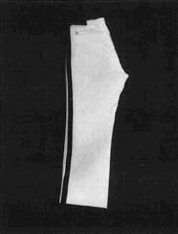 1. Fold at the center vertically. |
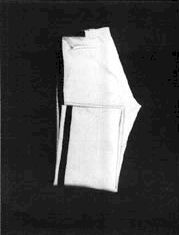 2. Fold on the third of the lower part. |
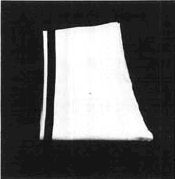 3. Fold again at the center. |
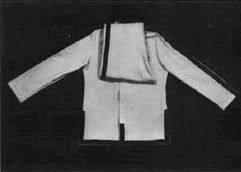 |
4. Place the folded pants on the shirt so the waist overlaps the collar. |
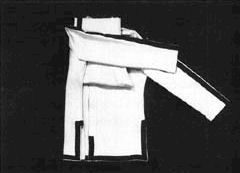 |
5. Fold one side inward first. |
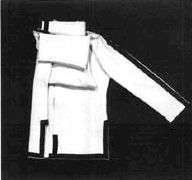 6. Fold the sleeve at the center |
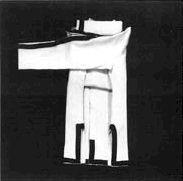 7. Fold the opposite side inward |
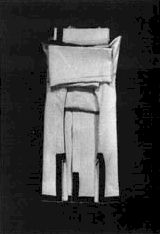 8. Fold the opposite sleeve at the center. |
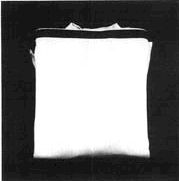 9. Fold the shirt at the center. |
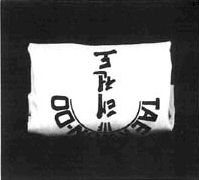 |
10. Fold again in half. |
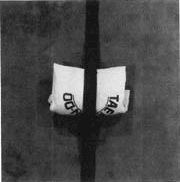 11. Place the center of the folded belt at the center of the folded dobok. |
12. Tie the belt with a square knot. . 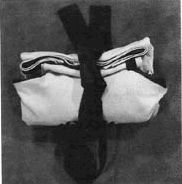 |
How to tie the belt
1. Hold the belt at the center.  |
2. Place the belt on the umbilicus.  |
3. Wrap it to the ribs.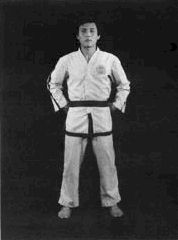 |
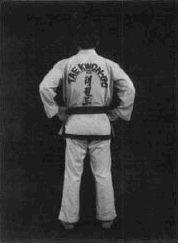 4. Cross it at the back keeping the belt held with the left hand under the other to prevent the belt from being twisted. 4. Cross it at the back keeping the belt held with the left hand under the other to prevent the belt from being twisted. |
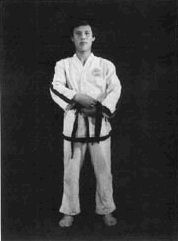 5. Bring the left hand to the abdomen, keeping it as it is. 5. Bring the left hand to the abdomen, keeping it as it is. |
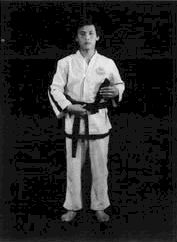 6. Cross the right end over the belt at the umbilicus. 6. Cross the right end over the belt at the umbilicus. |
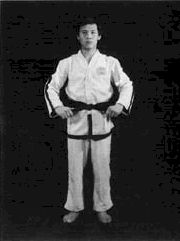 7. Tighten it with a square knot. 7. Tighten it with a square knot. |
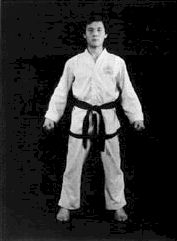 8. Both ends should be of the same length. 8. Both ends should be of the same length. |
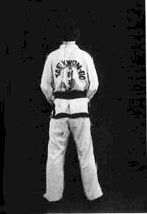 INCORRECT The belt is twisted. |
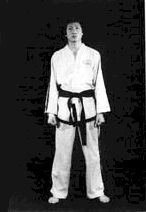 INCORRECT Both ends are not even. |
